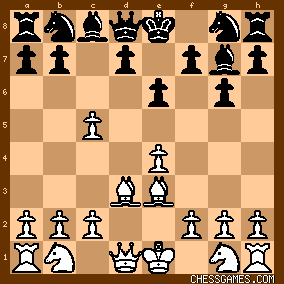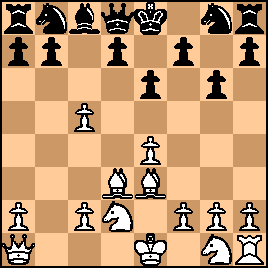|
< Earlier Kibitzing · PAGE 2 OF 2 ·
Later Kibitzing> |
Sep-02-04
 | | tamar: <IBM> <Borderline strange> Borderline is kind. This was the 11th game in 9 days. Anderssen plays like he is tired and has no time to prepare a proper opening. He played White against the weird g6 French setup versus Staunton in 1851, but Morphy probably knew it better than he did, and he has a winning position after 12 move. |
|
| Sep-03-04 | | JAIME OVIEDO: solicito informacion, de como puedo ver las partidas, no corre el java. |
|
| Sep-03-04 | | Lawrence: Hola, <JAIME OVIEDO>, bienvenido. Has probado cliquear sobre "troubleshooting"? |
|
| Jan-10-06 | | morpstau: I like your comments I>B.M. You speak the truth. Paul morphy plays this game flawlessly and obtains a good attack. Adolf on the other hand has to reconsiter who hes up against. This is not a regular human, indeed a machine who will trounce on your every mistake! Anderssen plays a very infferior french and is properly disposed of for good reason. |
|
| Mar-02-06 | | ckr: It is often said <Morphy couldn't play closed games> nothing could be further from the truth. In this game Morphy closes the position with 10.e5 and after the pawn exchange white has a spacial advantage on the king side. Black best defense is a QS offense, but Morphy gives him no time to launch one. His spacial advantage on the KS allows his pieces to just float into positions against the enemy king. 22. ...Bb5 <flagrant error of positional judgement>, possibly so since the exchange created the doubled pawns - but Anderssen had to get it off the 7th rank and 22...Bc6 while possibly better reduces the rook's scope on the c-file. In all, it was a flacky opening (Anderssen possibly wanting to stay off known lines) that quickly blew up in his face. Sometimes it works and sometimes not, but it happens to all
of us.
I also thought it unusual for Morphy to be developing his bishops first. |
|
| May-24-06 | | Rory O Rion: An interesting question arises on White's Queen move-20: Q-h4. . Why, i ask myself, didn't he play the 'natural-looking' Bxe7, followed by Ktxd5?
It's difficult to imagine Morphy didn't see it; i think most players(including myself) seeing it, would likely sucumb its temptation, but not Morphy: i wonder why? |
|
| May-24-06 | | who: 20.Bxe7 Qxe7 21.Nxd5?? exd5 (the bishop is protected by the queen)  |
|
| May-24-06 | | Rory O Rion: Duh . . of course! |
|
| Oct-18-06 | | schnarre: <ckr>Morphy can take full advantage of Black's passive opening play. Also the early ...g6 virtually begged for White's Dark-squared Bishop to be deployed. |
|
| Apr-21-07 | | gambitfan: I just scored 75 points with guess-the-move... |
|
| Jun-27-08 | | robichj: I love the way Morphy pinned the black bishop on G7. Morphy was the pin master. |
|
| Jan-18-09 | | WhiteRook48: there are other games where Morphy took advantage of pins. Often he pinned a bishop or knight. |
|
| Jan-28-09 | | birthtimes: Emanuel Lasker comments in his book "Lasker's Manual of Chess" the following after move 21: "Look at the aggregation of weak points [in Black's position]. The Black King and KB stand on an open line, a target for the [White] Rook. The point f6 is guarded only by the same KB, is overpoweringly assailed by Bishop and Queen and [e5] Pawn; hence, this point is a safe place for an effective advance post. Also, the Black KRP and the square h6 are weak. Black can support the position by Rc7 and by the Queen in the vicinity of the KB. The QB is in the way and its development costs a move. This sums up the weaknesses." Lasker further comments: "If 22...Qf8 23. Rh3, but for all that to abandon a Pawn was the most promising way out of Black's distress." Lasker also mentions: "If for instance, 24...Kh8; 25. Qh6 Qf8 26. Nxb5 axb5; the White reserve force, the King, decides the issue by attacking the advanced b-pawn while the Black pieces are held fast. 27. Rxg7 Rxg7 28. Kf2, etc." |
|
Jan-28-09
 | | sleepyirv: I feel it's worth pointing out that a lot of Morphy's games were played a piece down so he more or less HAD to play aggressive and go into open games to win. |
|
| Sep-12-09 | | kooley782: In response to a question why Anderssen did not play as brilliantly against Morphy as he did against others, Anderssen said, "Morphy will not let me." Excellent attack by Morphy! |
|
| Jul-08-10 | | kafkafan: Just did "guess the move" Andersson vs Staunton 1851 (French, 1-0 Andersson) and got 68 points. Then did this one immediately and got 80 points. Helps pattern recognition doing it this way (although it was by accident). |
|
| Feb-25-11 | | Llawdogg: Game Eleven: the Match is officially over. Morphy wins (7-2-2). It seems like Anderssen was exhausted and went out quietly. Morphy quickly got to a won endgame. |
|
| Jul-15-11 | | DrMAL: <Llawdogg: Game Eleven: the Match is officially over. Morphy wins (7-2-2).> Classical games: Wilhelm Steinitz tied Adolf Anderssen 11 to 11 (Need I write more?). |
|
Mar-24-12
 | | LoveThatJoker: Guess-the-Move Final Score:
Morphy vs Anderssen, 1858.
YOU ARE PLAYING THE ROLE OF MORPHY.
Your score: 91 (par = 77)
LTJ |
|
| Jun-07-12 | | Naniwazu: Anderssen plays the opening in a rather hypermodern way; the moves g6, Bg7 and c5 makes it resemble a sort of hybrid French/Gruenfeld Defense. |
|
| Mar-20-14 | | RookFile: Capa could have taken the white pieces in this game, and would have handled it the same way. |
|
| Mar-20-14 | | 1971: After 13..Nb4 I'm thinking I need the light squared Bishop to exchange it for the Knight coming to f5.
So I'll play 14. Bb1 for now, and make up for the loss of tempo when I play a3 and kick back the Knight, which would go back to c6 again impeding Black's light squared Bishop while also keeping the battery on the dark squares. Morphy's 14. Bg5! is smarter as it pins the Knight so I won't need the light squared Bishop, keeps the Rooks connected (hallmark of Morphy's play: speedy development and deployment of pieces) and I no longer need the dark squared battery as Black can't break the pin because then g6 hangs. Since Black just traded one of the defenders of the pinned Knight now the Queen is tied down meaning Rooks can't connect and his development is slowed down, giving white the luxury of only having to figure out what's the best way to build up the attack. Why, 16. Qh3! of course, and after Qh4 he doubles down and gets the monster d8-g5-h6 battery then bring the Knight to g3 to trade off the f5 knight. One thing to learn is never waste a tempo or disrupt coordination of your pieces. In this game we see a Fischeresque elimination of enemy good pieces, Karpovian control, Kasparovic build up of a kingside attack, done with the grace, simplicity, and ease of Capablanca. This is why they say Guess The Move is the best way to study. You can compare your line of thinking with the greats, and Paul Morphy might be the best teacher of them all. |
|
| Mar-20-14 | | 1971: 20...Nf5 is obviously fatal so maybe 20...Nc6 deserves attention, I would play 21. Nd1-e3 bringing the knight to the kingside but most probably ;) Morphy plays something faster. |
|
| Oct-11-15 | | The Kings Domain: Good match between the two greatest masters of the time. It's divine providence that the two met over the board for posterity. It's too bad Morphy never went to Germany to play a rematch with Anderssen and to challenge the German masters of the time. The world was denied a lot of good games. |
|
Apr-05-25
 | | kingscrusher: 5.dxc5 seems very strong and questions black's dark squares :
click for larger viewBxb2 6.Nd2 Bxa1 7.Qa1

click for larger viewis pretty bad for black. Even though there is f6, e5 marks out d6 ready for Nd2-c4-d6 |
|
 |
|
< Earlier Kibitzing · PAGE 2 OF 2 ·
Later Kibitzing> |





